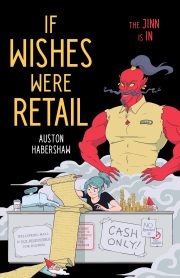Variations of Villainy
by Nancy Fulda
 Villains are challenging to write. Make them too heartless, and no one will find them believable. Make them too empathetic, and the audience will end up rooting for the wrong team. It can be difficult to create an antagonist with enough human virtue to be interesting and enough human foibles to be, well, villainous.
Villains are challenging to write. Make them too heartless, and no one will find them believable. Make them too empathetic, and the audience will end up rooting for the wrong team. It can be difficult to create an antagonist with enough human virtue to be interesting and enough human foibles to be, well, villainous.
Villains have their own priorities, goals, fears and aspirations. The more effectively you demonstrate these differences to the reader, the more compelling and believable your villains will become. The old adage, “Everyone’s the Hero of His Own Story” applies here.
There’s no one way to write a good villain, but there are a number of basic personality types which frequently appear in villainous characters. Understanding them can help you create the right villain for your story.
1. The Connoisseur
This is the black suited, mustache-twirling villain of children’s films; the cackling criminal in search of the perfect dastardly deed. This type of villain deplores goodness and kindness and seeks to be cruel for cruelty’s sake. Maleficent from Disney’s Sleeping Beauty, who despises the idea of love’s first kiss, was initially presented as this type of villain.
Connoisseur villains are seldom believable and often verge on the melodramatic, but they do have their place. There are times when, for reasons pertaining to audience, tone, or thematic exploration, it’s useful to present a villain’s choices without getting bogged down in the psychological and emotional spaces lurking beneath. Satire, comedy, hyperbole and crime fiction are examples of literature that is well-suited to this kind of villain. As a general rule, the Connoisseur is best utilized in situations where disbelief is inherently suspended or in which the complexity of the villain’s scheming – and not the complexity of the villain’s soul – are the reader’s primary concern.
A related manifestation of the Connoisseur is sometimes seen in epic fantasy. Authors in such genres may wish to keep the reader’s sympathies focused on the epic hero and her band of noble adventurers. It’s hard to root for a sword-swinging slayer of monsters if the monsters become too engaging. Therefore, the antagonists in such novels are often presented as a physical embodiment of evil. Sauron from The Lord of the Rings is a variation on this type of villain, as are the Nazis from the Indiana Jones movies.
2. The Outsider
The Outsider is attached to a different group, and therefore serves a different set of priorities, than the protagonist. Outsiders can be empathetic (like Magneto from X-Men), unscrupulously merciless (like Kahn from The Wrath of Kahn), or enigmatic (like the Hive Queen from Ender’s Game).
The distinctive characteristic of the Outsider is that he seeks the welfare of a different group than the protagonist. If the needs of the two groups conflict – and in genre fiction they almost certainly do – then hero and villain are thrust into a confrontation that neither of them has consciously sought.
The Outsider is best utilized when the conflict between groups, and not merely a contest between individuals, plays a prominent role in the story.
3. The Sociopath
This group includes psychopaths as well, although for simplicity I’ve chosen to use only one moniker.
The Sociopath villain thinks, feels, and experiences the world differently than the average human. Typically presented as a character largely lacking in human empathy, and hence capable of hideous crimes, this type of villain is a frequent choice of horror and crime writers. Serial killers, mass-murderers, and those bent on the destruction of humanity all fall into this group.
Although the sociopath is frequently used as a convenient cardboard cutout, hardly more than a faceless shadow whom the police must hunt down, the deep psychology of the socio- or psychopathic mind is fully capable supporting an entire book. The Silence of the Lambs by Thomas Harris and I am Not a Serial Killer by Dan Wells provide two examples.
4. The Mad Scientist
The Mad Scientist stands firm in the conviction that genius creates its own rules. Characterized by a sense of entitlement and a conviction that her actions need not be dictated by the expectations of society, the Mad Scientist pursues her own objectives. These may include an obsession with physical or chemical phenomena, a driving desire to unravel a mystery, or the dogged pursuit of a self-imposed vendetta. Dr. Octopus from Spiderman II is a prime example. Criminal Masterminds, like Professor Moriarty from the original Sherlock Holmes novels, are a variation on this type of villain.
The Mad Scientist villain does not necessarily focus on scientific research, and his fundamental motives need not always be evil. The desperate father searching for the cure to a child’s illness, the abused woman on a quest for justice, or magician enthralled by the possibilities of his newfound power can all fall prey to the fundamental conceit of the Mad Scientist. The common characteristic here is the villain’s conviction that he or she is exempt from the laws to which other people adhere. Normal rules no longer apply, and the Mad Scientist’s personal priorities take precedence over everything else.
The Mad Scientist is obsessed, often self-obsessed, and frequently exhibits megalomaniacal behavior. Emperor Palpatine from Star Wars is a classic example of the Mad Scientist.
5. The Everyday Villain
Not all villains are evil geniuses or criminal masterminds. In real life, the people who mistreat others seldom have a set of lofty ideals, misguided or otherwise. Instead, people tend to bumble into situations which allow – or require – the exploitation of others. This villain, too, can be of use in creating compelling fiction.
The Everyday Villain is characterized by two traits: (1) Poor judgment, and (2) The unwillingness to back down. He is Biff from Back to the Future, Malfoy from Harry Potter – the average guy who, having made one bad call, continues to stumble into ever murkier waters in the attempt to defend it. The Everyday Villain may begin as a schoolyard bully, a down-on-her luck teenager looking for a few thrills, or a middle-class businessman struggling to feed his family, and if things stopped there, there wouldn’t be much villainy in the story at all. But the Everyday Villain, once committed, refuses to back down.
About half the time, the Everyday Villain has a moment of revelation near the end of the story. He finds himself in an untenable situation, compelled to take actions he finds reprehensible, but unable to see a better alternative. “I never meant for things to go this far!” is his catch-phrase, and while he sometimes receives a moment of redemption near the end of the story, he is equally likely to take a moral nose-dive.
* * *
Naturally, villains seldom fit neatly into exactly one of the above categories. Many straddle the bridge between character types: the megalomaniac of the Mad Scientist combined with the fatal error in judgment typical of the Everyday Villain, for example, or the differing priorities of the Outsider mingled with the monochrome agenda of the Connoisseur. The objective of this article is not to create a black-and-white compartmentalization, but to offer insight into the fundamental motivations that drive people to oppose a story’s protagonist.
When creating villains, it’s helpful to ask the same questions one asks when creating protagonists. What does this person yearn for? What does she fear? What is the best thing that could possibly happen to her? What can she least afford to lose?
For story purposes, a villain exists to oppose the protagonist. But for believability purposes, the villain exists as a being in his own right. Take time to discover who he is, and your stories will be richer for it.
•••
Nancy Fulda is a past Hugo and Nebula Nominee, a Phobos Award winner, and a Jim Baen Memorial Award recipient. Get a free ebook by joining her mailing list.


